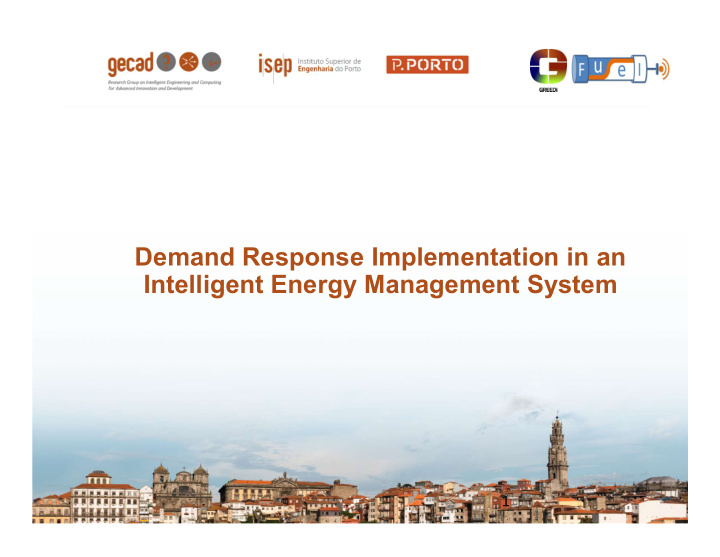



Demand Response Implementation in an Intelligent Energy Management System 1
Community Grid Model Community is a subset of the main grid Community Electricity Market Community Manager ISO • Community Manager (CM) • Community Members • • manages community members Producers, Consumers, Prosumers • • has direct connection with Some members have contracts electricity market with CM, some others do not have any contract. 2
Members Contracts with Community Manager • • Producers Consumers • • Offer the max generation capacity to Execute demand response programs the CM provided by CM • • Receive fixed payment mentioned in Receive incentives based on contract consumption curtailment/reduction • Prosumers Demand Response Contracts • Offer surplus of generation • Execute demand response programs DR M / Activation/ Measure/ Remuneration Type V** Signal Contract DLC per X events per • Receive fixed payment for generation DLC* M Power tariff discount equipment month • Red. Reduction Actual kWh Receive incentives for demand response V Cost/kWh reduced T1 notification reduction Actual Red. Actual kWh M Cost/kWh reduced consumption T2 reduction level notification N/A Electricity price Members can have more than one Pricing V (Reduced/Increased N/A notification energy costs) demand response contracts * Direct Load Control ** Mandatory – Voluntary 3
Real distribution network for Community model Location: • ISEP/IPP – Porto, Portugal Network features: • Internal low voltage network of university campus • Underground electrical lines (3.350 km) • 15 kV / 400V-230V, 2050 kVA • 21 Buses • MV/LV transformer in bus #21 4
iEMS (intelligent Energy Management System) Description BUS #15: GECAD Research Center GECAD Building: • 11 Offices • 2 Laboratories • 1 Server room • 1 Meeting room • 1 Kitchen • 2 Bathroom • 10 kW PV Generation Capacity Proposed Community members • • • 3 Consumers 4 Producers 13 Prosumers • • • Houses Wind Turbines Houses • • • Factories PV Factories • • Commercial Commercial Buildings Buildings 5
iEMS Web Panel • Temperature Outside • Light Outside • CO2 • VOC • Temperature • Humidity Sensors • Light 4 Energy meters • Presence 19 DALI Ballasts for lighting control 6
Optimization Model for Lighting System Inputs Optimization Results Total consumption Algorithm for PV generation Minimizing Consumption Number of offices Number of lights Consumption of each light Lights Scheduling • Lower priorities first Max consumption of each light • Do not turn all off Max reduction of each light • Keep a minimum Required Reduction illumination level for each room Max reduction Priority of each light 7
Real-Time Demonstration Constraints of Optimization Direction of Optimization Min. Lights Consumption = lp (“min”, priorities, coefficientsMat, directions, rhs) iEMS Optimization iEMS MODBUS TCP/IP MODBUS TCP/IP Input Output Real-Time Real-Time data Scheduling Actuation 8
The present work has been developed under the EUREKA - ITEA2 Project FUSE-IT (ITEA-13023), Project GREEDI (ANI|P2020 17822), and has received funding from FEDER Funds through COMPETE program and from National Funds through FCT under the project UID/EEA/00760/2013. 9
Thank you for your attention! Questions
Recommend
More recommend